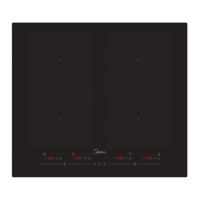Why does the fan motor sound abnormal on Midea Hob?
- KKelly CortezSep 10, 2025
If the fan motor on your Midea Hob sounds abnormal, the fan motor is damaged and needs to be replaced.

Why does the fan motor sound abnormal on Midea Hob?
If the fan motor on your Midea Hob sounds abnormal, the fan motor is damaged and needs to be replaced.
What does EF mean on Midea MC-6F74A0H556 Hob?
If you see 'EF' displayed on your Midea Hob, it means two or more keys are triggered for a long time. Clean the operation area.
What does C1 mean on Midea MC-6F74A0H556?
If 'C1' appears on your Midea Hob, it indicates that the temperature sensor of the ceramic glass plate is high. Restart the hob after it cools down.
What does C2 mean on Midea MC-6F74A0H556?
If 'C2' appears on your Midea Hob, it indicates that the temperature sensor of the IGBT is high. Please restart after the induction hob cools down.
| Number of Burners | 4 |
|---|---|
| Material | Stainless Steel |
| Ignition Type | Automatic |
| Weight | 8.5 kg |
| Type | Gas |
Defines the proper and safe use of the appliance to prevent risks and damage.
Details various symbols used in the manual to convey warnings and important information.
Covers electrical shock and cut hazards during installation, and general safety guidelines.
Key safety guidelines for appliance installation, including earthing, circuit protection, and qualified personnel.
Illustrates the layout of the induction hob's cooking zones and glass plate.
Explains the function of each control button on the induction hob's panel.
Provides advice on reducing cooking times, saving energy, and optimal heat settings.
Guides on achieving perfect simmered dishes and cooking rice using the absorption method.
Step-by-step instructions for cooking juicy steaks, including resting and checking doneness.
Advice on preparing ingredients and cooking vegetables and meat for stir-fries.
Details requirements for cutting work surfaces and selecting heat-resistant materials for installation.
Ensures proper ventilation to prevent overheating and electric shock during operation.
Covers checks for work surface, material, oven compatibility, and electrical connections before installation.
Ensures power supply cable safety, adequate airflow, and accessibility of the isolating switch after installation.
Guides on placing the hob on a stable surface and adjusting brackets for table top thickness.
Highlights key safety points like professional installation, avoiding direct installation above appliances, and heat resistance.
Details how to use the touch controls, including pressure, finger use, and keeping controls clean and dry.
Explains how to identify suitable induction cookware using a magnet test or water heating method.
Specifies the minimum and maximum base diameter for cookware on different cooking zones.
Guides on activating the hob, placing suitable pans, and ensuring clean, dry surfaces.
Explains how to use the boost function for rapid heating and how it automatically cancels.
Provides details on boost function duration, zone return settings, and interaction between cooking zones.
Describes using the flexible zone as a single or two zones and requirements for pan detection.
Details how to lock controls to prevent unintended use and unlock them.
Explains how to set and adjust timers for individual heat zones and the flex zone.
Describes how to pause active cooking zones and resume them.
Explains how to activate, deactivate, and use the pan transfer function between zones.
Instructions for cleaning fingerprints, marks, and non-sugary spills from the glass surface.
Guidance on removing sticky or hot spills, including using scrapers and safety precautions.
Steps for cleaning spills on touch controls, ensuring they are completely dry before use.
Compliance with WEEE Directive for proper disposal of electrical equipment and recycling points.
Confirms compliance with the RoHS Directive regarding prohibited materials.
Details on recycling packaging materials according to national regulations and local collection points.
